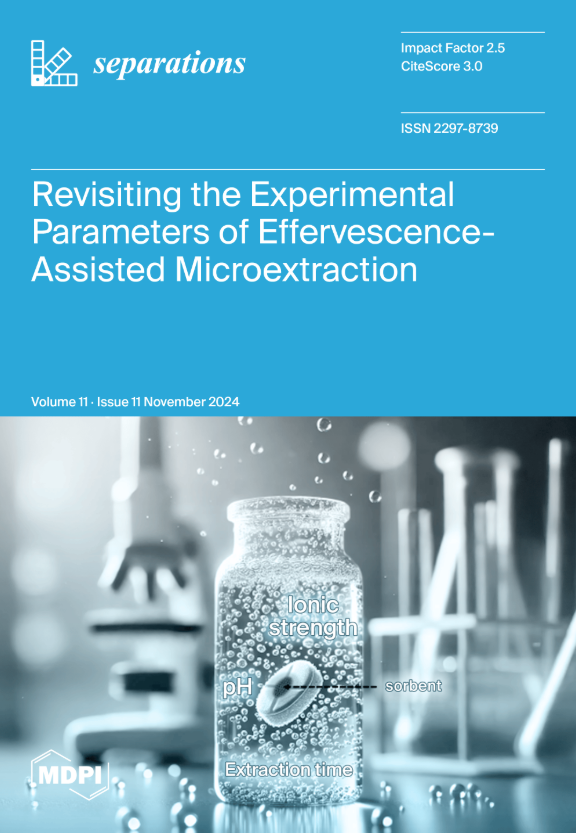Selective H2 Evolution and CO2 Absorption in Electrolysis of Ethanolamine Aqueous Solutions
IF 2.7
4区 工程技术
Q3 CHEMISTRY, ANALYTICAL
引用次数: 0
Abstract
Selective H2 evolution and CO2 absorption in several ethanolamine aqueous solutions are comparatively investigated using a new electrolysis reactor. H2 bubbles are generated from a cathode in any ethanolamine electrolyte, and its experimental gas evolution rates are correlated by Faraday’s first rule. No or smaller amounts of CO2 and N2 bubbles than stoichiometric ones are generated on an anode through the reaction between hydroxide ions and ethanolamine ones. No CO or O2 is observed in the system exhaust, and most of the CO2, along with N2, is still absorbed in ethanolamine aqueous solutions with the addition of KOH and/or HCOOH under high pH conditions. Variations of the concentrations of coexisting ions dissolved in the electrolytes of mono- or tri-ethanolamine (MEA or TEA) and ethylenediamine (EDA) solutions with CO2 absorption are calculated using the equilibrium constants to relate the concentrations of solute ions. Electric resistivities of the ethanolamine aqueous solutions are correlated by the pH value and are analyzed in terms of equilibrium constants among the concentrations of coexisting ions. Conditions of the MEA electrolyte to achieve high-performance electrolysis is discussed for selective H2 generation.乙醇胺水溶液电解过程中的选择性 H2 蒸发和 CO2 吸收
利用新型电解反应器对几种乙醇胺水溶液中 H2 的选择性进化和 CO2 的吸收进行了比较研究。在任何乙醇胺电解质中,阴极都会产生 H2 气泡,其实验气体进化速率与法拉第第一定律相关。通过氢氧根离子和乙醇胺离子之间的反应,阳极上不会产生二氧化碳和二氧化氮气泡,或者产生的气泡数量少于定量气泡。在高 pH 条件下,加入 KOH 和/或 HCOOH 后,乙醇胺水溶液仍可吸收大部分 CO2 和 N2。利用平衡常数计算了溶质离子浓度与一乙醇胺或三乙醇胺(MEA 或 TEA)和乙二胺(EDA)溶液中溶解的共存离子浓度随二氧化碳吸收量的变化情况。乙醇胺水溶液的电阻值与 pH 值相关,并根据共存离子浓度之间的平衡常数进行分析。讨论了 MEA 电解质实现高性能电解的条件,以便选择性生成 H2。
本文章由计算机程序翻译,如有差异,请以英文原文为准。
求助全文
约1分钟内获得全文
求助全文
来源期刊

Separations
Chemistry-Analytical Chemistry
CiteScore
3.00
自引率
15.40%
发文量
342
审稿时长
12 weeks
期刊介绍:
Separations (formerly Chromatography, ISSN 2227-9075, CODEN: CHROBV) provides an advanced forum for separation and purification science and technology in all areas of chemical, biological and physical science. It publishes reviews, regular research papers and communications. Our aim is to encourage scientists to publish their experimental and theoretical results in as much detail as possible. There is no restriction on the length of the papers. The full experimental details must be provided so that the results can be reproduced. There are, in addition, unique features of this journal:
Manuscripts regarding research proposals and research ideas will be particularly welcomed.
Electronic files and software regarding the full details of the calculation and experimental procedure, if unable to be published in a normal way, can be deposited as supplementary material.
Manuscripts concerning summaries and surveys on research cooperation and projects (that are funded by national governments) to give information for a broad field of users.
The scope of the journal includes but is not limited to:
Theory and methodology (theory of separation methods, sample preparation, instrumental and column developments, new separation methodologies, etc.)
Equipment and techniques, novel hyphenated analytical solutions (significantly extended by their combination with spectroscopic methods and in particular, mass spectrometry)
Novel analysis approaches and applications to solve analytical challenges which utilize chromatographic separations as a key step in the overall solution
Computational modelling of separations for the purpose of fundamental understanding and/or chromatographic optimization
 求助内容:
求助内容: 应助结果提醒方式:
应助结果提醒方式:


